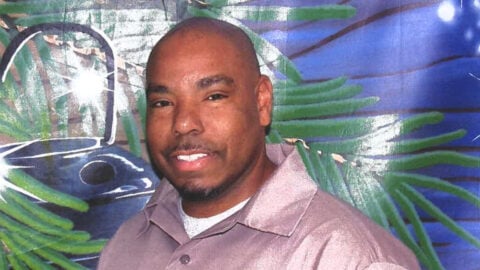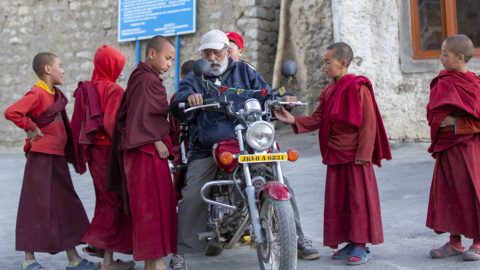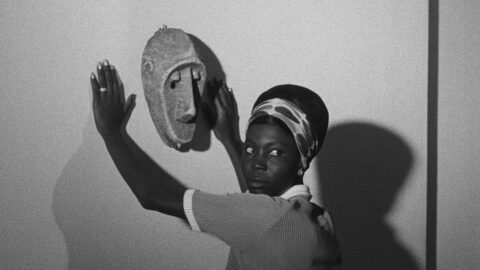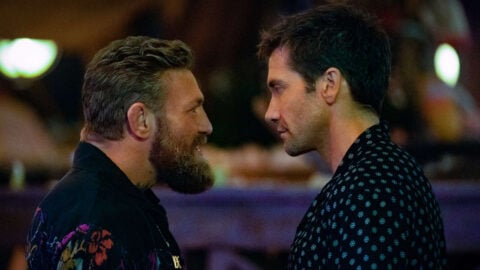Tell It Like It Is: Black Independents in New York
William Greaves: “Now, a lot black people feel that our reactions to various events that go on here in America are totally reactive. We never seem to initiate things. Black power never seems to have a self-originating nature to it. Why is that, Professor Hamilton?”
Charles V. Hamilton [Professor of Political Science, Columbia University]: “It’s very difficult. The weaker you are in a society, the less resources you have to start anything . . . I know the argument you’re making, and I know that to a large extent it’s correct. But keep in mind that blacks are a minority: numerically, politically, economically. So it’s very difficult to initiate things from that position. So I don’t see that so much as a criticism. The problem is, do they fail to react properly when the occasion develops? It’s a conservative system, built on self-interest.”
—Black Power in America: Myth or Reality? (1986)

Within Our Gates
Unlike other movements of the 20th century such as Third Cinema or Cinema Novo that sought to reconfigure or subvert dominant cinematic forms and narratives, there is no single, easily identifiable moment that inaugurated or crystallized black independent filmmaking in the U.S. Though some argue that D.W. Griffith’s Civil War melodrama cum Ku Klux Klan recruitment film Birth of a Nation threw down the gauntlet, with the first and most notable response being filmmaker Oscar Micheaux’s 1920 refutation Within Our Gates, the Chicago-based Foster Photoplay Company had been producing shorts with all-black casts and crews since 1910. William Foster, the company’s founder and a journalist who wrote for many black newspapers across the country, argued passionately for the importance of film and its ability to uplift the community both inside and out.
Throughout its multiple “waves,” black filmmaking in the U.S. has been defined by that desire to refute and complicate portrayals of blackness in Hollywood films, but also by virtue of its independent production. The types of films made by the “L.A. Rebellion”—its most prominent members being Charles Burnett, Julie Dash, Larry Clark, Billy Woodberry, and Haile Gerima—are distinguished from those made by their contemporary counterparts in New York not merely by virtue of their shared experience of attending UCLA, but also because public television played a different role in the East for black independent filmmakers. The films featured in “Tell It Like It Is: Black Independents in New York, 1968–1986” at the Film Society of Lincoln Center showcase the work of black independent filmmakers based in New York, many of which are not available on DVD or have gone unseen since their original broadcasts.

Pearl Bowser, Bill Gunn, and Katherine Collins (photo courtesy of PJ Bowser Productions)
Of course, the vast majority of black filmmaking in the U.S. has necessarily been independent—there has yet to be an African American CEO of a Hollywood studio, and, save for a handful of outliers like Warner Brothers’ The Green Pastures (36), the majors didn’t produce films with entirely or predominantly black casts (or “race films”) until the Seventies. Most black filmmakers have historically been forced to serve as producer and distributor in addition to writing, directing, and editing duties. While this is increasingly true of contemporary filmmakers of varying distinction in the age of digital, combining these roles meant something very different back then: it effectively shut these films out of block-booked, studio-owned theaters as well as out of many film publications, whose editorial policies restricted their coverage only to films with distribution. (Films made for public television usually suffered a similar fate.) Many historians have argued that Micheaux’s distinctive, “imperfect” style—minimal editing, poor sound, fumbled lines, and overextended scenes in which the performers stare off into space—is equally understandable as a jazz-like reinterpretation of the rules of Classical Hollywood (much in the way African-American English reconfigures American English) and as a fiscally motivated strategy. Though Micheaux made 44 films that he exhibited across the chitlin circuit in impromptu screening venues like churches, schools, homes, and barbershops, he was constantly forced to borrow money and sell off assets to continue making them.
The ways in which the jack-of-all-trades demands of independent filmmaking shaped form and story are apparent in the careers of Jessie Maple, the first African-American woman to gain entry into the New York camera operators union, and William Greaves, whose importance in the New York scene was aptly described in former colleague St. Clair Bourne’s Chamba Notes: “If the black independent film movement of the 1960s-1970s were to be symbolized by a band, William Greaves would be the bass.” Greaves began his career as a successful actor on radio, television, film, and Broadway in the late Forties, and gained membership to the Actors Studio. However, Greaves grew increasingly frustrated by the “Uncle Tom” roles he was routinely offered, and by the industry’s treatment of black actors at large, so he refocused his efforts towards directing and producing films instead. After studying filmmaking at City College, Greaves moved to Canada to escape the dual oppression of racism and McCarthyism, and got a job making documentaries with the National Film Board. He filmed the landmark 1966 World Festival of Black Arts in Senegal for a U.N.-sponsored organization (they only wanted a five-minute clip; he eventually turned his footage into a feature), and then returned to New York, splitting his time between that position and work for National Educational Television (NET, later WNET-13). In 1968, the network developed a nationally syndicated monthly magazine show by and for African Americans called Black Journal, on which Greaves served as producer and co-host. Though the initial episodes were akin to 60 Minutes, concerns about representation in staff led to a strike and a white producer’s transition to being a “consultant”; subsequent episodes ended with the greeting and signoff addressed to “brothers and sisters,” and Greaves, along with being promoted to executive producer, traded in his suit for a dashiki. The year Black Journal began also marked the release of Greaves’s landmark hybrid documentary, Symbiopsychotaxiplasm: Take One, in which a crew attempts to document a crew shooting two actors running through a facile break-up scene in Central Park. The film’s complicated structure reflects a keen familiarity with the different roles on a shoot, questioning the creative process at every level, from the crew (who revolt against their sexist, incompetent black director, played by Greaves) to the actors (who Greaves knew from the Actors Studio) during rehearsal and improvisation. The conflicts that sometimes bubble forth are born out of the actors’ actual frustrations, and in turn collapse traditional filmmaking roles as the cast take on responsibilities traditionally belonging to the screenwriter; likewise, Greaves’s fictional failings parody the bumbling roles typically given to black actors.

Black Journal
Black Journal was able to broach new subjects and themes as ambitious as those in Symbiopsychotaxiplasm, in part because of its “by us for us” commitment to staffing and WNET’s hands-off approach, which may have been influenced by the country’s tense racial climate amidst riots occurring across the country. These auspicious production conditions also allowed the show to serve as incubator for up-and-coming black talent: Madeline Anderson, initially an editor on the show, wrote, directed, and produced several documentaries for Black Journal that encompassed the breadth of the civil rights struggle, such as A Tribute to Malcolm X (67) and I Am Somebody (70). The powerful I Am Somebody, a tag-along look at striking hospital workers in Charleston, North Carolina, depicts the intersection of class, race, and gender in this primarily female-led triumph for labor rights, but also subtly questions conventional American historical narratives. The film’s voiceover narration, read by one the strike’s participants, begins with her discussing Charleston’s typical springtime tourist attractions: Fort Sumter (where the first shots of the Civil War were fired), “our stately historic mansions,” the “lovely gardens.” While she identifies these places as being far away from “the real Charleston,” her use of “our” subtly evokes the crucial role black labor played (and continued to play) in the creation and upkeep of these picturesque attractions. The sense of this unevenly shared heritage is further underscored when Southern Christian Leadership Conference leader Reverend Abernathy comes to speak at one of the hospital union’s strikes and jokingly bemoans the fact that every time he’s visited Charleston, he’s been forced to visit those historic sites again and again. It’s a pleasantry with an edge—a plea for the black community to be successful and for them to make their own mark on history—as another leader states, “when hospital workers make a little more money, we all can make a little more.” Later, the strikers are shown strategically moving their marches to “The Battery,” a historic seaside promenade (so named for its role in the civil war), and being bolstered by the support of student walkouts; the film’s final (staged) image is of the narrator strolling along the same area alone in her 1199 union hat, proud of their collective achievement. Anderson’s layering of several time frames—the Antebellum past, the local history of labor actions, and the consequences today of the black community’s success—is quietly brilliant.
The focus on community, not just the individual, is also apparent in the work of Charles Hobson, a former WBAI radio producer who moved into directing and producing documentaries for television in 1968 with the weekly WNEW program Inside Bedford-Stuyvesant. Hosted by Jim Lowry and later Jeffersons actress Roxie Roker, the program—the first black-produced show in the country—was created to counter negative images of black neighborhoods on the nightly news, and functioned as a forum with representatives from across the spectrum of the Brooklyn community: local business owners, activists, kids, teachers, and celebrities local and otherwise. (One episode opens with Harry Belafonte sitting in a park, fielding questions from an eager crowd.) The limitations of respectability politics—the dictum to “uplift the race” by adopting the values and manners of white society—were complicated early on in documentaries like Kent Garrett’s The Black Cop (69) and The Black GI (71), which deal with the “perpetual outsider status” of African Americans and pose questions about those who serve to protect rights historically denied to black communities. Later on, what comes after achieving respectability was explored within black middle-class families: Larry Bullard and Carolyn Johnson’s striking A Dream Is What You Wake Up From (78) employs vignettes and self-reflexive techniques to question the American dream and the accepted role of black women in families; and Camille Billops and James Hatch’s emotionally raw Suzanne, Suzanne (82) shows Billops's own California family, torn apart from the inside by domestic violence, female body-image issues, and heroin abuse.

Suzanne, Suzanne
St. Clair Bourne, a Black Journal alum (who helped organize the staff strike that led to Greaves’s promotion), sought to broadcast the activities of black communities to audiences domestically and abroad using CHAMBA Notes, an internationally distributed newsletter of critical essays about films, news events, and social issues named after his production company, and with films like The Black and the Green (83), which explored the civil rights movement’s influence on Catholics in Northern Ireland fighting for independence. The resulting 40-minute documentary is both a startlingly frank account of Belfast’s tormented cityscape and an invaluable record of the remarkable conversations between five black American ministers and activists and various IRA organizers. While many criticized the film as pro-IRA, Bourne argued that it was part of his “Sixties humanist approach,” and that the film was better understood as “a step in my own development, and perhaps for documentaries in America, if a situation that is not clearly identifiable as ‘black-American’ can be looked at by black Americans.” In Motion: Amiri Baraka, a portrait of the iconic revolutionary and beat poet that, through a chance meeting at an anti-Apartheid demonstration, led Bourne to create The Black and the Green, was also considered highly controversial upon its release (though any documentary about Baraka that goes down easy is fundamentally misunderstanding its subject).
Bourne’s commitment to generating such dialogues, pushing form forward, and filling in gaps of representation in front of and behind the camera is evidenced by the quality and quantity of his output (he directed or produced over 40 films in his 36-year career). But his legacy is also apparent in the younger black filmmakers he mentored, and his 1988 documentary about the making of Spike Lee’s Do the Right Thing, a recognition of that film’s historical importance. The success of Lee’s film—along with those working in Los Angeles—marked Hollywood’s renewed interest in black filmmakers, and inaugurated a cycle of films about black life such as House Party (90), Boyz N the Hood (91), and Juice (92). These studio attempts at cashing in mirrored the trend of Blaxploitation in the Seventies inaugurated by Mario Van Peebles’s pimp odyssey (per Toni Cade Bambara, “Stagolee meets [Frantz] Fanon”), Sweet Sweetback’s Baadasssss Song (71), and Bill Gunn’s 1973 fusion of African spirituality, Black churches, and European vampire horror, Ganja and Hess. Like many of the black independent filmmakers working with fiction who were unable to rely on production support from public television, almost a decade would pass before Gunn’s second and final directed feature, Personal Problems (80), was completed. Like Greaves, Gunn had begun as actor in New York and switched to writing and directing; however, he was largely dissatisfied with how Columbia handled his screenplays for 1970’s The Angel Levine and The Landlord. (He channeled these experiences into a novel with the suitably Gunn-esque title Rhinestone Sharecropping.) Personal Problems was conceived with writer Ishmael Reed, and lives up to Reed’s description as “experimental soap opera.” Although the film’s form is fragmented, reflexive, and sometimes veers into abstraction, the black middle-class characters are painted in ironically broad strokes: Johnnie Mae (Vertamae Grosvenor), a nurse at Harlem Hosptial, wants to pursue poetry but feels fenced in by her tiny apartment, which houses her husband, father-in-law, half-brother, and sister-in-law. (She attempts escape by drinking with her girlfriends and an ultimately unsatisfying affair.)

On the set of Personal Problems
This variety of black, middle-class creative malaise spilling over into extramarital affairs also fuels Kathleen Collins’s superb, newly restored Losing Ground (82), which features Gunn as an actor. Philosophy professor Sara (Seret Scott) obligingly follows her painter husband Victor (Bill Gunn) to a small town in upstate New York for the summer, even though it complicates her attempts to finish her own academic work on the nature of ecstasy. Victor has recently abandoned abstract expressionism (the style of his longtime mentor) in favor of representational work, and feels connected to his new surroundings—and to the very attractive, young Puerto Rican women who have the run of the town. Feeling increasingly left out, Sara accepts a flamboyant student’s invitation to act in his thesis film (“a meditation on the tragic mulatto”—aka a filmed interpretation of the song “Frankie and Johnny”) alongside his wise, aging actor uncle Duke (Duane Jones, the protagonist of Night of the Living Dead). Collins’s depiction of academia is incredibly astute, particularly in the interactions with her students (the boys unapologetically hit on her; a type-A personality girl visits during office hours), and her depiction of a marriage slowly stagnating is understated and devastatingly real.
But perhaps most impressive is Collins’s explorations of black female sexuality. Sara’s mother is an actress who wishes she could play “a real 60-year-old negro lady, who thinks more about men than God,” and is dismissive of her daughter’s academic career because she doesn’t consider it to be creative in any respect. Sara meanwhile, with her oversized glasses and bun, at first comes across as nebbishy and nerdy, lamenting her inability to just let go or tell a pompous co-worker, “Ain’t that a blip?” This, of course, makes her analysis of ecstasy even more painful—she’s missing the point by turning it into a mental exercise rather than just going with it. But she comes close to having a breakthrough in her dance performances for her student’s film and her on-screen chats with Duke, who seems far more compatible with her than cranky, self-absorbed Victor. However, the alternatives to her current life never truly materialize for Sara. The enthusiastic director constantly barks orders at her during the film shoot, exerting control at every moment; so too does her husband run the show when posing his (always female) subjects for portraits. Under these traditional conditions of artistic production, creative control seems to be firmly rooted in the masculine: her mother describes how her longtime partner was turned off by her post-stage fugue state; at another moment, the camera looks through the student director’s framing monocle. At the end of the student’s film (and Collins’s), Sara’s character arrives with a gun and shoots Duke for dancing with another woman—a scene that mirrors her husband’s poolside betrayal with his favorite model earlier that day. Victor pulls up to the set (an empty stretch of the City College campus), and watches as she acts out this scene, tears streaming from her eyes.

Losing Ground
While it’s tempting to read this as a feminist moment, her very real tears aren’t only from heartbreak, but also from frustration: she has no other option except to shoot. This masterful finale, born of rage and realized with supreme control, is a fitting image for black independent filmmaking in the U.S., a work in progress, driven by passion and necessity.







